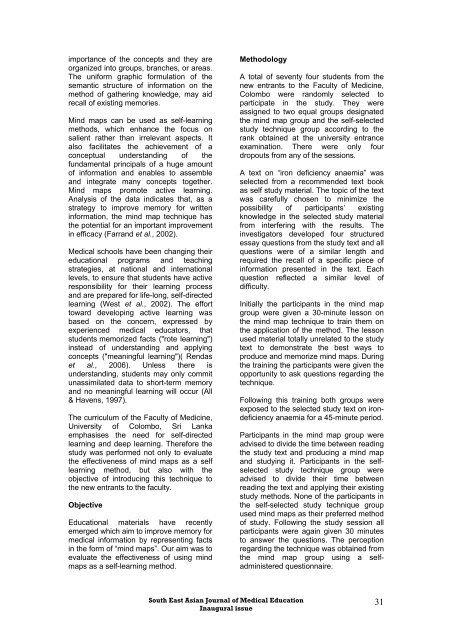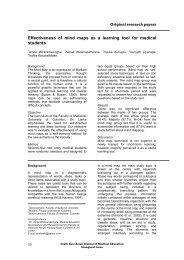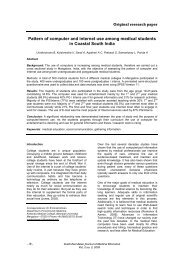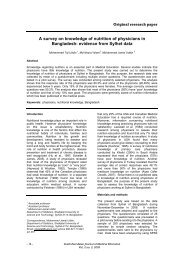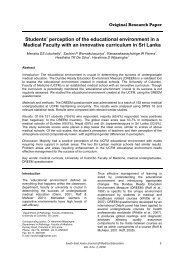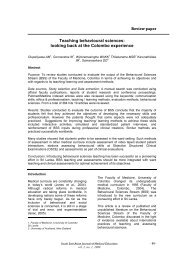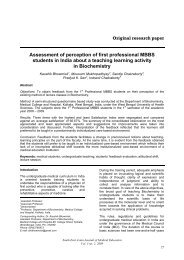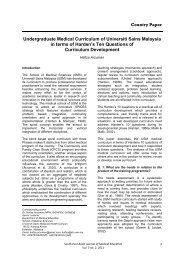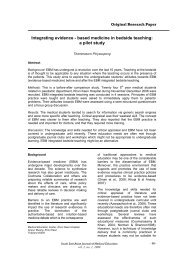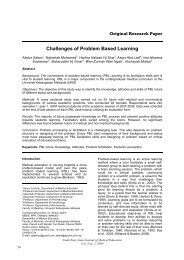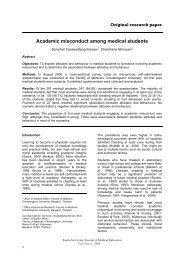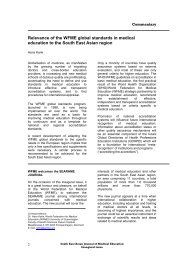Untitled - South East Asian Journal of Medical Education
Untitled - South East Asian Journal of Medical Education
Untitled - South East Asian Journal of Medical Education
You also want an ePaper? Increase the reach of your titles
YUMPU automatically turns print PDFs into web optimized ePapers that Google loves.
importance <strong>of</strong> the concepts and they areorganized into groups, branches, or areas.The uniform graphic formulation <strong>of</strong> thesemantic structure <strong>of</strong> information on themethod <strong>of</strong> gathering knowledge, may aidrecall <strong>of</strong> existing memories.Mind maps can be used as self-learningmethods, which enhance the focus onsalient rather than irrelevant aspects. Italso facilitates the achievement <strong>of</strong> aconceptual understanding <strong>of</strong> thefundamental principals <strong>of</strong> a huge amount<strong>of</strong> information and enables to assembleand integrate many concepts together.Mind maps promote active learning.Analysis <strong>of</strong> the data indicates that, as astrategy to improve memory for writteninformation, the mind map technique hasthe potential for an important improvementin efficacy (Farrand et al., 2002).<strong>Medical</strong> schools have been changing theireducational programs and teachingstrategies, at national and internationallevels, to ensure that students have activeresponsibility for their learning processand are prepared for life-long, self-directedlearning (West et al., 2002). The efforttoward developing active learning wasbased on the concern, expressed byexperienced medical educators, thatstudents memorized facts ("rote learning")instead <strong>of</strong> understanding and applyingconcepts ("meaningful learning")( Rendaset al., 2006). Unless there isunderstanding, students may only commitunassimilated data to short-term memoryand no meaningful learning will occur (All& Havens, 1997).The curriculum <strong>of</strong> the Faculty <strong>of</strong> Medicine,University <strong>of</strong> Colombo, Sri Lankaemphasises the need for self-directedlearning and deep learning. Therefore thestudy was performed not only to evaluatethe effectiveness <strong>of</strong> mind maps as a selflearning method, but also with theobjective <strong>of</strong> introducing this technique tothe new entrants to the faculty.Objective<strong>Education</strong>al materials have recentlyemerged which aim to improve memory formedical information by representing factsin the form <strong>of</strong> “mind maps”. Our aim was toevaluate the effectiveness <strong>of</strong> using mindmaps as a self-learning method.MethodologyA total <strong>of</strong> seventy four students from thenew entrants to the Faculty <strong>of</strong> Medicine,Colombo were randomly selected toparticipate in the study. They wereassigned to two equal groups designatedthe mind map group and the self-selectedstudy technique group according to therank obtained at the university entranceexamination. There were only fourdropouts from any <strong>of</strong> the sessions.A text on “iron deficiency anaemia” wasselected from a recommended text bookas self study material. The topic <strong>of</strong> the textwas carefully chosen to minimize thepossibility <strong>of</strong> participants’ existingknowledge in the selected study materialfrom interfering with the results. Theinvestigators developed four structuredessay questions from the study text and allquestions were <strong>of</strong> a similar length andrequired the recall <strong>of</strong> a specific piece <strong>of</strong>information presented in the text. Eachquestion reflected a similar level <strong>of</strong>difficulty.Initially the participants in the mind mapgroup were given a 30-minute lesson onthe mind map technique to train them onthe application <strong>of</strong> the method. The lessonused material totally unrelated to the studytext to demonstrate the best ways toproduce and memorize mind maps. Duringthe training the participants were given theopportunity to ask questions regarding thetechnique.Following this training both groups wereexposed to the selected study text on irondeficiencyanaemia for a 45-minute period.Participants in the mind map group wereadvised to divide the time between readingthe study text and producing a mind mapand studying it. Participants in the selfselectedstudy technique group wereadvised to divide their time betweenreading the text and applying their existingstudy methods. None <strong>of</strong> the participants inthe self-selected study technique groupused mind maps as their preferred method<strong>of</strong> study. Following the study session allparticipants were again given 30 minutesto answer the questions. The perceptionregarding the technique was obtained fromthe mind map group using a selfadministeredquestionnaire.<strong>South</strong> <strong>East</strong> <strong>Asian</strong> <strong>Journal</strong> <strong>of</strong> <strong>Medical</strong> <strong>Education</strong>Inaugural issue31


